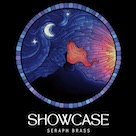

Seraph Brass: Showcase
Tower Grove Records
When renowned classical trumpeter Mary Elizabeth Bowden founded Seraph Brass in 2014, her goal for the all-women ensemble was to expand on the existing repertoire of brass chamber music and bring attention to work by underrepresented composers. Said goals are ably met and them some with their latest album Showcase, aptly titled in featuring pieces by American composers Jeff Scott, Reena Esmail, Kevin Day, and Kevin McKee and showcasing the superior musicianship of the group's members. Joining Bowden are trumpeters Raquel Samayoa, Jean Laurenz, and Sarah Jessen, who appear alongside trombonist Elisabeth Shafer, French hornist Rachel Velvikis, and tubist Cristina Cutts. For the record, while Seraph Brass is generally represented as a quintet, the group is a flexible unit that's performed as a ten-piece; further to that, seven brass players, not five, are credited on Showcase (the quintet format is still retained, however, when different combinations of trumpet pairs are utilized in the five pieces).
The material presented on the new release is representative of the group in its emphasis on new material; however, the five pieces are only a sampling of the repertoire Seraph Brass has created. Works by Jennifer Jolley, Joseph Hallman, Catherine McMichael, Marcus Grant, and Rene Orth have also been commissioned, with those by Orth and McMichael appearing on the group's debut release Asteria. Seraph Brass also collaborates with other outfits, a recent example Jolley's Dust, scored for brass quintet and wind ensemble, and the group regularly performs with symphony orchestras and for audiences around the world. With members holding teaching positions at the University of North Texas, Shenandoah Conservatory, Texas State University, and Texas Lutheran University, education is also a central part of Seraph Brass's mission. As expected, its members are involved in many activities outside of the group, all of which feed into the dynamic energy of the ensemble. Samayoa, for instance, is also principal trumpet with the Richardson Symphony Orchestra and a member of Lantana Trio.
Day's Fantasia III initiates the set with a vibrant three-movement work that captivates immediately with the exuberant fanfares of “Promenade.” The florid playing and virtuosity of the ensemble impress from the outset, whether it be during unison statements or passages of counterpoint. The lustrous central movement “Lunaire” is less intense than the opener but no less engaging when its focus is on soulful dignity. “Flamagra” reinstates the dynamism of “Promenade,” the playing staggering in its vitality and precision. The single-movement titular work by Scott showcases a style he calls “Urban Classical Music” for drawing on the music he absorbed growing up in Queens and Brooklyn—forms derived from West African rhythms such as jazz, salsa, and hip-hop—and learned formally studying classical music. The piece elicits from the ensemble a characteristically inspired performance as it advances through multiple episodes during its eight-minute journey, some blazing and blustery and others controlled.
Esmail's Khirkiyaan: Three Transformations for Brass Quintet is so titled because each movement presents a reimagining and reshaping for brass quintet of an earlier composition. As Khirkiyaan means "windows" in Hindi, each part acts as a window into Esmail's musical world. “Jog,” not surprisingly, is a jubilant and breathless romp, the dramatic “Joota” a slower and ponderous rumination, and “Tuttarana” an energized dynamo tinged with Spanish flavour. McKee's Vuelta del Fuego picks up where “Tuttarana” leaves off with eight minutes of sweeping, matador-like gestures and lush polyphony.
Perhaps the album's biggest surprise arrives at the end when Laurenz's arrangement of the Celtic folk traditional “Parting Glass” includes an appealing and natural vocal by the trumpeter. She describes it as a poignant farewell tune that originally was delivered while quaffing “a final drink for the road as part of a hospitality tradition from the seventeenth and eighteenth centuries in Ireland, Scotland, and other countries”; over time, however, it's become a popular choice for funerals and New Years gatherings for the way it marks ends and beginnings. Consistent with that, Laurenz arranged it so that the singing component is associated with the ending of an event and the triumphant solo trumpet the start of something new (not insignificantly, she crafted the piece after having a baby and as such left pre-motherhood behind to embrace her new role).
No one could possibly describe the ensemble's playing as anything but inspired and enthusiastic on this commanding collection. Seraph Brass's engagement with the material is total, regardless of whether the work is aggressive and uptempo or something more contemplative and plaintive. It is, quite literally, a tremendous showcase for the group.
May 2025